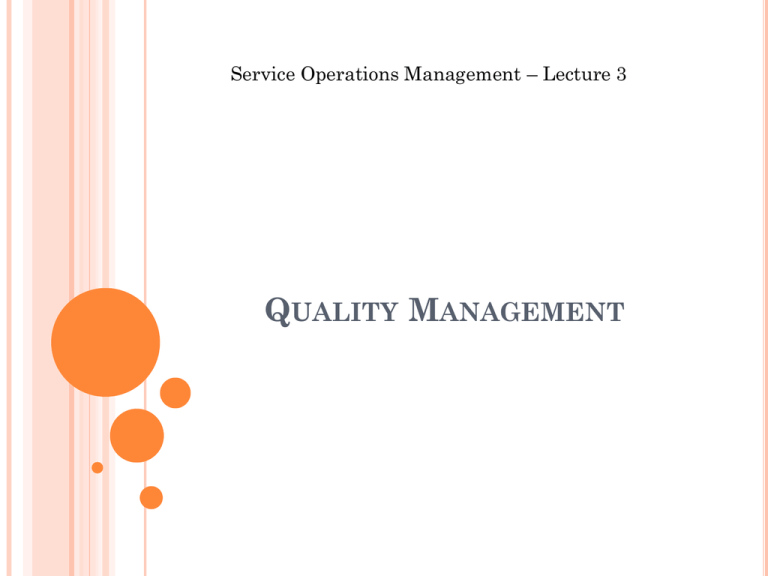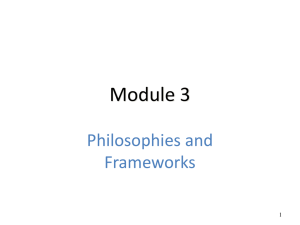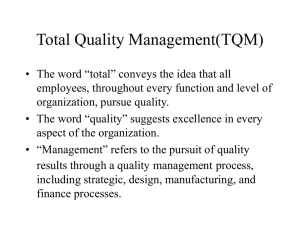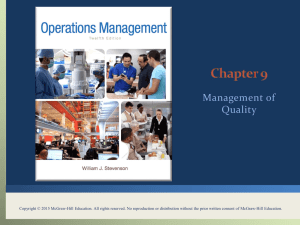Quality Management
advertisement

Service Operations Management – Lecture 3 QUALITY MANAGEMENT WHAT IS QUALITY? Ability to satisfy needs of customers (British Standard 4778, 1987) An abstract concept that is difficult to define (Garvin 1984, 1987, Sweetney & Soutar, 1995, Zeithaml 1988) Referred to perceived quality (Bolton & Drew 1991: Jacoby& Olson, 1985) QUALITY GURUS Dr. W. Edward Demings Dr. Joseph Juran Philip Bayard Crossby Armand V Feigenbaum Dr. Kaoru Ishikawa Walter Shewart Dr. Genichi Taguchi QUALITY GURUS Dr Walter A Shewart Uses statistics to explain process variability Developed the control chart as well as the PDCA or PDSA Dr Edwards Demings Argued that higher quality leads to higher productivity, hence leading to long term competitive advantage. QUALITY GURUS Philip Bayard Crosby argued about basic theories of quality Quality means conformance to requirements The system of causing quality is prevention The performance standard must be zero defects The measurement of quality is the price of nonconformance. QUALITY GURUS Dr Joseph Juran Used to establish a traditional quality system Includes quality trilogy & quality roadmap Dr Kaoru Ishikawa Is considered as the father of quality circle movement He promoted the quality circle to: support improvement Respect human relationships in workplaces Increase job satisfaction More fully recognize employees capabilities & utilize their ideas OTHER QUALITY GURUS Dr Genichi Taguchi Frederick Taylor Dr H James Harrighton, among others They have all contributed in improving organisations around the world. DIMENSIONS OF QUALITY SERVICE Features Courtesy Reliability Consistency Conformance Accuracy Durability Accessibility Safety Responsiveness Perceptions Completeness Time Total Quality Management MANUFACTURED PRODUCTS Performance SERVICE SECTOR TIME- waiting time RESPONSIVENESS- problem solving ACCESSIBILITY- easy access to service Total Quality Management COURTESY- customer care CONSISTENCY- same level of service ACCURACY- spontaneous service TQM (TOTAL QUALITY MANAGEMENT) Total Therefore, TQM is the art of managing the whole to achieve excellence. Total Quality Management - made up of the whole Quality - degree of excellence a product or service provides Management - act, art or manner of planning, controlling, directing,…. WHAT’S THE GOAL OF TQM? Total Quality Management “Do the right things right the first time, every time.” PRINCIPLES OF TQM Total Total Quality Management employee involvement Continuous improvement Continuous training Teamwork Empowerment Top mgt commitment & support Customer/citizen satisfaction COST OF QUALITY WHAT IS COST OF QUALITY? “… costs related to actions taken to get the service right from the start, auditing that it is correctly delivered and the expenses of responding to any failure.” (Lockyer and Oakland, 1981) COST OF QUALITY The reworking of a manufactured item The retesting of an assembly The rebuilding of a tool The correction of a bank statement The reworking of a service sector, such as replacement of a food order in a restaurant COST OF QUALITY Costs Examples Failure costs Errors, correction, checking, dealing with customer complaints, the costs of getting it wrong Appraisal costs Checking, inspection, quality audits, checking that it is right Prevention costs Planning training, good procedures, getting it right first time Lockyer and Oakland (1981) FAILURE COSTS (COST OF POOR QUALITY) The costs resulting from products or services not conforming to requirements or customer/user needs. Failure costs can divided into Internal and External failure categories. INTERNAL FAILURE COSTS (COST OF NONCONFORMANCE) Scrap costs - The labor, material, and (usually) overhead on defective product that cannot economically be repaired. The titles are numerous—scrap, spoilage, defectives, etc. Rework costs - Correcting defectives in physical products or errors in service products. Failure analysis - Analyzing nonconforming goods or services to determine causes Process downtime costs – Costs of shutting down productive process to fix problems Price-downgrading costs - The difference between the normal selling price and the reduced price due to quality reasons. EXTERNAL FAILURE COSTS External Failure costs are costs associated with deficiencies that are found after product is received by the customer. External Failure Costs included are lost opportunities for sales revenue. These costs also would disappear if there were no deficiencies. EXTERNAL FAILURE COSTS Warranty charges - The costs involved in replacing or making repairs to products that are still within the warranty period. Complaint adjustment - The costs of investigation and adjustment of justified complaints attributable to defective product or installation. Returned Materials - The costs associated with receipt and replacement of defective product received from the field. New customers lost because of quality - Profit on potential customers lost because of poor quality. Allowances - The costs of concessions made to customers due to substandard products accepted by the customer as is or to conforming product that does not meet customer needs. APPRAISAL COSTS Final inspection and test - Evaluation of conformance to requirements for product acceptance. Maintaining accuracy of test equipment - Keeping measuring instruments and equipment in calibration. Evaluation of stocks - Testing products in field storage or in stock to evaluate degradation. PREVENTION COST Process planning - Training - Preparing and conducting quality-related Process capability studies, inspection planning, and other activities associated with the manufacturing and service processes. training programs. Quality planning – Quality audits - Evaluating the execution of activities in cost of developing implementing quality management program and the overall quality plan New Product Review - Reliability engineering and other quality-related activities associated with the launching of new design. MEASURING COST OF QUALITY Index Numbers Labor ratio of quality cost to labor hours Cost index Ratio of quality cost to manufacturing cost Sales index index production index Ratio of quality cost to sales Production index Ratio of quality cost to units of final products QUALITY/COST RELATIONSHIP Cost of Quality Difference between price of nonconformance and conformance Cost of doing things wrong 20% to 35% of revenues Cost of doing things right 3% to 4% of revenues Profitability in the long run, quality is free QUALITY MANAGEMENT DEFINITION OF QUALITY MANAGEMENT Quality management is an organization-wide approach to understanding precisely what customers need and consistently delivering accurate solutions within budget, on time and with the minimum loss to society. COMPONENTS OF QUALITY MANAGEMENT Quality management can be considered to have three main components: quality control, quality assurance quality improvement QUALITY ASSURANCE & QUALITY CONTROL Quality assurance or QA, is concerned with making sure that quality is designed into the service package and remains as it is produced and given to the customer. Quality control is a process employed to ensure a certain level of quality in a product or service. The basic goal of quality control is to ensure that the products, services and processes provided meet specific requirements and satisfactory QUALITY ASSURANCE Steps to implement QA in Service Industry: Identify The Expectations Of The Customers Determine The Standards Measure And Compare Performance Analyze Plan STEPS OF QUALITY ASSURANCE 1st step: Identify The Expectations Of The Customers Knowing what customer expect is the first and possibly most critical step in delivering quality service. STEPS OF QUALITY ASSURANCE 2nd Step : Determine standards Depending on the feedback and expectations that organization can determine its quality standards. STEPS OF QUALITY ASSURANCE 3rd step: Measure and Compare Current performance should be measured or can also be compared with target quality standards to find gap. STEPS OF QUALITY ASSURANCE 4th step: Analyze Find the cause and gap. The entire workforce should be encouraged to participate in the process. STEPS OF QUALITY ASSURANCE 5th step: Plan Depending upon the gap and the problems , organization should plan to achieve its set quality goals. QUALITY CONTROL Maintain the quality consistently by covering the following : Products/ services Process People QUALITY IMPROVEMENT QUALITY IMPROVEMENT • • • To support and develop a process of continuous improvement in Quality-selection of quality tools and techniques. Peter(1987) suggested if customer perception of service is “excellent” and it consistently meets their needs, the organization will establish a reputation . For example , Ritz hotel and Disneyland. QUALITY IMPROVEMENT [CONT’D] Crosby’s fourteen step quality improvement program: 1. 2. 3. 4. 5. 6. 7. 8. 9. 10. 11. 12. 13. 14. Management commitment Quality improvement team Quality measurement Cost of quality evaluation Quality awareness Corrective action Establish an ad hoc committee for the zero defect programme Supervisor training Zero defects day Goal setting Error cause removal Recognition Quality councils Do it over again Quality is managed by 3 interrelated processes: Quality planning Quality control Quality Improvement Knowing what customer needs help to make continuous improvement The approach towards quality improvement is not new, it was already advocated by Quality Gurus(Deming 1986,Juran 1988a) Some examples of quality improvement are: Kaizen Total Quality Management Quality circle ROLE OF EMPLOYEES The quality of service and the level of customer satisfaction will be highly dependant upon the employee who interacts with the guest Employee involvement and empowerment can improve decision making in the service industry Training QUALITY CIRCLE 3-15 of volunteers Implementation Problem Analysis monitoring Problem identification suggestions QUALITY AWARDS Quality awards are the formal recognition of quality achievements given to organizations by quality bodies. Quality awards used by organizations for self assessment purposes International Awards such as: Malcom Bridge National Quality Award(MBNQA) European Quality Award(EQA) QUALITY AWARDS [CONT’D] o Deming Prize The Deming Prize is the oldest quality award dating back to 1951. It is regarded as extremely prestigious award in Japan. Applicants are judged in 10 aspects of quality management: policy and objectives o Malcom Baldrige National Award Inspired by the Deming Prize, the MBNQA was introduced in 1987 The assessment process is similar to Deming Prize but used 9 criteria: Leadership Information and Analysis Organization and its operation Strategic planning Education and its extension Customer and market focus Assembly and dissemination of information Information analysis Human Resource focus Process management Business results Customer and market focus analysis Standardization Control Quality assurance Results Effects and the future plans ISO 9000 ISO 9000 is a generic standard. It can be applied to any organization that intends to set up a quality management. ISO is a worldwide federation of national standards and the ISO 9000 is a series of internationally accepted guidelines. The ISO 9000 series define and set out a list of features and characteristics which should be present in an organization’s documented policies, manual and procedures. The term “isos” is a Greek word meaning equal, homogenous or uniform. This is precisely the idea behind ISO 9000 which is an attempt to bring in uniformity in the quality standards prevailing. Aim-systematic quality assurance and control General terms which are defined in the standards and not the specific methods by which control can be achieved. Hotels are different: use of ISO for contract purposes ISO 9000[CONT’D] Why standard matter? The standard have 2 main functions: the first one is an introduction to series and this identifies the aspects to be covered by organization’s quality system Standards ensure desirable characteristics of product and services such as quality , environmental friendliness, safety In the absence of standards we soon notice it. ISO STANDARDS • • • Make the development, manufacturing and supply of products and services more efficient, safer and cleaner. Provide governments with a technical base for health, safety and environmental legislation and conformity assessment. Safeguard consumers ISO 9001:2000 In 2000,the ISO-9000 was revised ISO-9001:2000-applies to all organizations including services, manufacturing and govt. Purpose-is to establish a management system that provides confidence to producing org ISO-9004:2000-gives guidelines for performance improvements EXAMPLES OF ISO 9001:2000 Air Mauritius Naiade Resorts






